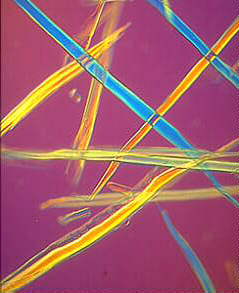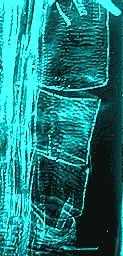
The xylem is the principal water-conducting tissue of vascular plants. It consists of tracheary elements, tracheids and wood vessels and of additional xylem fibres. All of them are elongated cells with secondary cell walls that lack protoplasts at maturity. Bordered pits are typical for tracheids, while wood vessels are marked by perforated or completely dissolved final walls.
The xylem takes also part in food storage, support and the conduction of minerals. Xylem and phloem together form a continuous system of vascular tissue extending throughout the plant. The principal conductive cells of the xylem are tracheary elements, of which there are two types, tracheids and wood vessels. Both are elongated cells with secondary cell walls that lack protoplasts at maturity. They are completed by the xylem fibres and parenchyma cells. Much speaks on behalf of the origin of xylem fibres and wood vessels from the tracheids.
Since 1851, the isolation and depiction of lignified cells is done
according to the maceration procedure of SCHULZE. Small pieces of
wood are covered with a mixture of potassium perchlorate and
concentrated nitric acid. The complete volume should not be larger
than 1/10 of the reaction container, because a lot of gas develops
very quickly at cautious heating. The surfaces of the wooden pieces
are strongly attacked. The single cells can be scraped off after
washing of the preparation and examined under the microscope.
 Let us start with a portrait of the different cell types.:Tracheids
are the chief water-conducting elements in gymnosperms and seedless
vascular plants. They can also be found in angiosperms. Tracheids are
elongated cells, closed at both ends. They are 1 mm on average.
Tracheids are regarded as the prototype of prosenchymatic cells,
since the cell's ends are pointed and true final walls are missing.
Tracheids look often square in cross-section, the lignified secondary
wall is relatively thin. Their entire cell surface is evenly coated.
The walls are opened by numerous pits that
are, depending on their origin, either round, oval, gap- or
groove-shaped. They occur solitarily, statistically scattered,
arranged in turns around the middle axis or grouped together. Such
groups can often be found at the cell's ends. If gap-like pits lay on
top of one another, a ladder- or stair-like perforation may be the
result. It is commonly called scalariform. We will meet this
structure again, when talking about vessel elements. The pits are
often surrounded by a halo and are then called
bordered pits. Bordered
pits are especially common in the tracheids of some gymnosperms.
Their structure can be discerned best in a cross-section through
neighbouring cells. The middle lamina between the cells is preserved
within the pits. Their centre is made up by a disc of primary cell
wall material, called torus. No
secondary walls exists in the pit's structure. The area between torus
and wall (the former middle lamina) is called
margo and is very porous,
allowing the movement of water and ions from tracheid to tracheid.
Bordered pits exist only in cells with secondary walls.
Let us start with a portrait of the different cell types.:Tracheids
are the chief water-conducting elements in gymnosperms and seedless
vascular plants. They can also be found in angiosperms. Tracheids are
elongated cells, closed at both ends. They are 1 mm on average.
Tracheids are regarded as the prototype of prosenchymatic cells,
since the cell's ends are pointed and true final walls are missing.
Tracheids look often square in cross-section, the lignified secondary
wall is relatively thin. Their entire cell surface is evenly coated.
The walls are opened by numerous pits that
are, depending on their origin, either round, oval, gap- or
groove-shaped. They occur solitarily, statistically scattered,
arranged in turns around the middle axis or grouped together. Such
groups can often be found at the cell's ends. If gap-like pits lay on
top of one another, a ladder- or stair-like perforation may be the
result. It is commonly called scalariform. We will meet this
structure again, when talking about vessel elements. The pits are
often surrounded by a halo and are then called
bordered pits. Bordered
pits are especially common in the tracheids of some gymnosperms.
Their structure can be discerned best in a cross-section through
neighbouring cells. The middle lamina between the cells is preserved
within the pits. Their centre is made up by a disc of primary cell
wall material, called torus. No
secondary walls exists in the pit's structure. The area between torus
and wall (the former middle lamina) is called
margo and is very porous,
allowing the movement of water and ions from tracheid to tracheid.
Bordered pits exist only in cells with secondary walls.
Botanists think of wood
vessels (tracheae) as the water-filled tubes of the xylem.
M. MALPIGHI, who thought that he
had found an important common element in the anatomy of animals and
plants introduced the term trachea in the 17th century. Wood vessels
are the chief water-conducting elements of angiosperms.

In contrast to the tracheids the final walls of the single vessels are perforated or, much more so, completely resolved. Wood vessels are therefore generally thought to be more efficient water conductors than tracheids. The length of the single tube (composed of numerous cells) makes it difficult to isolate a vessel as a whole. It can be as long as several meters. It is commonly assumed that at least in some species the wood vessels are as long as the whole shoot.
During ontogenesis the wood vessels increase strongly in width.They are usually round in cross-section and have a larger diameter than the tracheids, a feature that enhances their capacity for water-conduct. Exceptionally wide-lumened elements can be seen with deciduous trees, that are known to lose particularly large amounts of water due to transpiration. The water-loss of a fully developed birch tree with an estimated number of 200 000 leaves can be up to 400 litres per day. Even wider are the vessel elements of many lianas. But the oldest living trees, the redwoods and other sequoias at the pacific coast of California have without exception tracheids with very narrow lumina. Vessels are marked by characteristically structured secondary wall coatings (lignin) at the inner surface of the primary walls. Deposits in the form of screws, rings or nets exist. These strengthenings make it possible for tracheary elements to be stretched or extended, although the cells are frequently destroyed during the overall elongation of the organ.
Beside this vessels with pits or scalariform openings exist, whose walls are nearly completely lined with secondary wall material that is only opened by round or gap-like pits. Many transitions between the two pit types can be found. Often some or even all of the types are members of the same vascular bundle. But there are species, that lack one or the other type. Wood vessels develop -just like tracheids- during primary growth from the cells of the procambium. Where secondary growth occurs wood vessels are produced by the cells of the cambium.
|
|